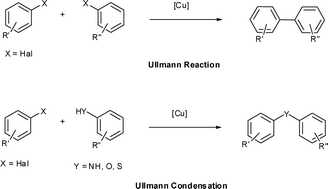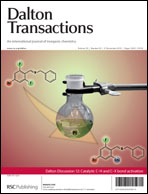The copper-mediated aromatic nucleophilic substitution reactions developed by Fritz Ullmann and Irma Goldberg required stoichiometric amounts of copper and very high reaction temperatures. Recently, it was found that addition of relatively cheap ligands (diamines, aminoalcohols, diketones, diols) made these reactions truly catalytic, with catalyst amounts as low as 1 mol% or even lower. Since these catalysts are homogeneous, it has opened up the possibility to investigate the mechanism of these modified Ullmann reactions. Most authors agree that Cu(I) is the true catalyst even though Cu(0) and Cu(II) catalysts have also shown to be active. It should be noted however that Cu(I) is capable of reversible disproportionation into Cu(0) and Cu(II). In the first step, the nucleophile displaces the halide in the LnCu(I)X complex forming LnCu(I)ZR (Z = O, NR′, S). Quite a number of mechanisms have been proposed for the actual reaction of this complex with the aryl halide: 1. Oxidative addition of ArX forming a Cu(III) intermediate followed by reductive elimination; 2. Sigma bond metathesis; in this mechanism copper remains in the Cu(II) oxidation state; 3. Single electron transfer (SET) in which a radical anion of the aryl halide is formed (Cu(I)/Cu(II)); 4. Iodine atom transfer (IAT) to give the aryl radical (Cu(I)/Cu(II)); 5. π-complexation of the aryl halide with the Cu(I) complex, which is thought to enable the nucleophilic substitution reaction. Initially, the radical type mechanisms 3 and 4 where discounted based on the fact that radical clock-type experiments with ortho-allyl aryl halides failed to give the cyclised products. However, a recent DFT study by Houk, Buchwald and co-workers shows that the modified Ullmann reaction between aryl iodide and amines or primary alcohols proceeds either via an SET or an IAT mechanism. Van Koten has shown that stalled aminations can be rejuvenated by the addition of Cu(0), which serves to reduce the formed Cu(II) to Cu(I); this also corroborates a Cu(I)/Cu(II) mechanism. Thus the use of radical clock type experiments in these metal catalysed reactions is not reliable. DFT calculations from Hartwig seem to confirm a Cu(I)/Cu(III) type mechanism for the amidation (Goldberg) reaction, although not all possible mechanisms were calculated.

You have access to this article
 Please wait while we load your content...
Something went wrong. Try again?
Please wait while we load your content...
Something went wrong. Try again?


 Please wait while we load your content...
Please wait while we load your content...